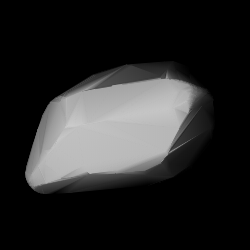 Bruce Helin modeled from its lightcurve | |
| Discovery [1] | |
|---|---|
| Discovered by | E. F. Helin E. Shoemaker |
| Discovery site | Palomar Obs. |
| Discovery date | 8 November 1977 |
| Designations | |
| (2430) Bruce Helin | |
Named after | Bruce Helin [2] (son of Eleanor Helin) |
| 1977 VC ·1976 JU1 A908 WC | |
| main-belt · Phocaea [3] [4] | |
| Orbital characteristics [1] | |
| Epoch 4 September 2017 (JD 2458000.5) | |
| Uncertainty parameter 0 | |
| Observation arc | 40.44 yr (14,772 days) |
| Aphelion | 2.8697 AU |
| Perihelion | 1.8555 AU |
| 2.3626 AU | |
| Eccentricity | 0.2146 |
| 3.63 yr (1,326 days) | |
| 21.845° | |
| 0° 16m 17.04s / day | |
| Inclination | 23.459° |
| 45.854° | |
| 309.89° | |
| Physical characteristics | |
| 128 h [a] 129.4163±0.3970 h [7] 129.75 h [8] | |
| 11.693±0.003(R) [7] ·11.70 [6] ·11.8 [1] [3] ·12.24 [5] | |
2430 Bruce Helin (prov. designation: 1977 VC) is a stony Phocaea asteroid and slow rotator from the inner regions of the asteroid belt. It was discovered by American astronomers Eleanor Helin and Eugene Shoemaker at the U.S. Palomar Observatory in California, on 8 November 1977. [9] It was later named after Bruce Helin, son of the first discoverer. [2] The S-type asteroid (Sl) has an exceptionally long rotation period of 128 hours and measures approximately 12 kilometers (7.5 miles) in diameter.